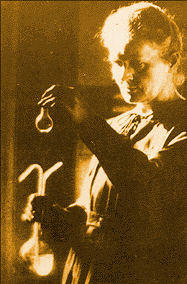Marie Curie (1867-1934)
 (Courtesy of the
University of Virginia's site)
(Courtesy of the
University of Virginia's site)
Marie Curie is the most famous woman of physics. She has been recognized for her work with Nobel Prize awards in both
physics (1903) and chemistry (1911). She got a late start with her education obtaining her license in physics in 1893 and the
corresponding degree in mathematics in 1894. In 1903, she finally received her doctorate. Choosing raioactivity as a thesis topic,
Madame Curie examined a number of substances and found that thorium and its compounds behaved the same way as uranium.
While examining pitchblende, a uranium ore, she discovered radium and polonium. In 1910 she succeeded in isolating pure
radium metal. Marie Curie was also instrumental in setting up the Curie laboratory in Paris. She died in 1934 of leukemia,
thought to have been brought on by her extensive exposure to the high levels of radiation involved in her studies. .
Marie Curie & Radiology
A more detailed biography of Marie Curie
 (Courtesy of the
University of Virginia's site)
(Courtesy of the
University of Virginia's site)